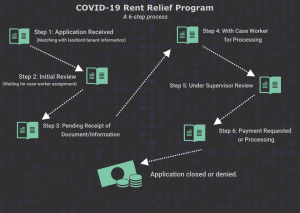Montgomery County’s COVID-19 Rent Relief Program helps renters avoid eviction, but local experts say more preventative measures are needed to avoid a housing crisis.
Tuesday afternoon the County Council will vote on Expedited Bill 30-21, which would cap landlords’ ability to raise rent during the pandemic. It would also stop the accrual of late fees on rent payments.
“The last thing you want to do is pile onto folks who are already trying to dig out,” said Councilmember Will Jawando, who sponsored the bill.
If passed, the bill goes into immediate effect and will be enforced through August of 2022.
On Aug. 15, 2021, Governor Larry Hogan ended the COVID-19 state of emergency for Maryland, despite many calls to extend it. The loss of the eviction moratorium created by the state of emergency could result in a housing crisis over the next few months, according to community advocate Jane Lyons.
Lyons is the Maryland Advocacy Manager for Coalition for Smarter Growth, a local nonprofit focused on promoting inclusive, accessible communities in the Washington metropolitan area.
Montgomery County spearheaded COVID-19 prevention efforts in many other areas, Lyons said, citing mask mandates, vaccine requirements and quarantine efforts. So when it comes to this crucial issue, she said it’s “frustrating to see that we can’t be a leader.”
The county’s Rent Relief Program, run by the Department of Health and Human Services, provides up to $12,000 or 15 months of assistance to eligible households behind on rent due to pandemic-related income loss. The program received $31 million in emergency funds from the federal government.
Tenants can apply for assistance online. Once they fill out an application, their case is assigned to a caseworker who will then follow it through the six-step process.
Some residents have been “understandably” frustrated, Jawando said, because the process tends to take “a while.” Lyons shared his concern, saying residents tend to be “overwhelmed or confused” by the application.

DHHS has received 8,577 unique applications as of Sept. 26, they reported in a briefing. Jawando reported that as of Sept. 23, payment had been issued in 50% of all submitted applications, and 30% were being processed by caseworkers.
Over 100 employees work in the program, according to Amanda Harris, who heads rent relief efforts as DHHS’s Chief of Services to End and Prevent Homelessness.
Harris said her team is allowed to use up to 10% of the treasury’s emergency rental assistance fund for administrative costs. She said they are “maximizing” that 10% to pay caseworkers’ salaries.
The Rent Relief Program prioritizes funding for cases where evictions are already scheduled. DHHS has a data-sharing agreement with the Sheriff’s Office, Harris explained. Her team is provided with a list of households scheduled for eviction each week. County employees then reach out to those households, and their cases become top priority.
The Sheriff’s Office notifies DHHS of between 13 to 15 scheduled evictions per week, Harris said. That figure has stayed consistent over the past six weeks.
Harris also suggested those numbers could be inflated by cases involving commercial properties and cases where the tenant has already either moved or paid their debt. Less than 8% of eviction notices result in a physical eviction, she said.
Looking forward, she expressed confidence in the county’s trajectory, stating, “There is no tsunami of evictions coming.”
For at-need residents with slightly more of a buffer keeping them from eviction, the Rent Relief Program can be challenging.
Local freelance writer Stewart Schulze rushed to submit his application when the program launched but has received no update on its status in the three and a half months since. Because he hasn’t received an eviction notice from his landlord, he’s been told his application is still on a waiting list.
“They don’t know how to intervene. They only know how to respond to crisis,” he said in an interview, referring to the program as “just plain triage.”
Councilmember Jawando also called the program a “triaging” effort. He said DHHS’s relationship with the Sheriff’s Office allows for some level of proactivity but agreed that “we need more.”
Amanda Harris said she believes the program’s reactive efforts to combat homelessness need to be coupled with preventative measures, like addressing the county’s lack of affordable housing.

“We don’t have enough money to help every single person,” Harris said. “We just don’t. So we have to be able to prioritize those most likely to experience eviction and homelessness.”
Schulze said he has studied homelessness. He explained that according to his research, stabilization is the best way to prevent a housing crisis. The way the Rent Relief Program operates, “it’s like they want you to be homeless before they’ll even do anything.”
Councilmember Jawando echoed Schulze’s desire to see proactive eviction prevention. He expressed frustration at the lack of state and federal assistance, pointing out that when Governor Hogan “inexplicably let the state of emergency expire,” statewide safeguards disappeared.
Although Jawando said he believes passing Expedited Bill 30-21 today is an “urgent” necessity, more is still needed. He said he hopes to see a second wave of federal funds distributed as soon as possible.
“We’re looking at potentially allocating more into rent relief, but I do think there will be a need for more money at the federal level.”















Add comment